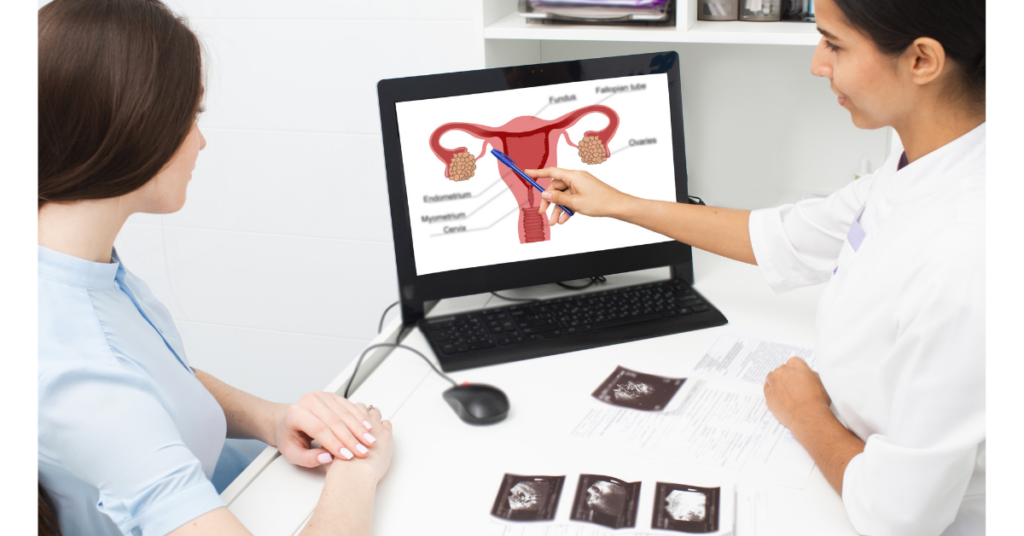What is Endometriosis?
Endometriosis is a fairly common condition, affecting up to 15% of all women. It develops when particles of the womb lining (endometrium) start to grow outside the womb lining, most commonly on the ovaries. Other areas of particle growth include the surface of the Fallopian tubes, the ligaments supporting the uterus, the uterus, and the pelvic cavity.
On rare occasions they also appear on the intestines, on abdominal surgery scars, between the rectum and vagina, in / on the bladder, and even in the lung region.
During a period, these particles react to the hormonal changes of the menstrual cycle and bleed, leading to a variety of symptoms.
Signs and symptoms
Blood clots in the pelvic region (see our article on Menorrhagia – Heavy Periods)
Pain before / during menstruation or during sex (see also our article on Dysmenorrhoea – Painful Periods)
Dark brown discharge
Painful bowel movement / urination
Subfertility (between 30-40% of women with endometriosis cannot conceive)
Pain during ovulation
Bloating
Backache
Nausea
Dizziness
Diarrhoea or constipation
Possible causes
The exact cause of this condition is unknown. However, there are several theories including links to excess hormonal production and genetic factors. Also, ‘retrograde menstruation’ may play a part. This is a condition where during the period a small amount of the menstrual blood, containing tiny seedlings of the womb lining, flows backwards down the Fallopian tubes and into the pelvic cavity.
However, it is not known why this may lead to endometriosis in some women but not in others. It may have something to do with the strength of an individual’s immune system-the ability to fight off and remove these seedlings.
Another notion put forward is that the particles from the endometrium travel in the blood stream, reaching such far-flung places as the lungs. Again, one’s immune response is seen as playing a significant part in the outcome.
Diagnosis
Pelvic examination.
Diagnostic laparoscopy whereby a small telescope is passed through the umbilicus to gain access to the pelvis.
Ultrasound scan is useful to diagnose endometriosis affecting the ovaries.
Conventional Treatment Strategies
No treatment at all: In cases where the endometriosis is mild and causing no symptoms at all.
Painkillers: To manage the symptoms (for example reduce painful periods).
Hormonal treatment: To shrink the endometriosis.
Surgery
Complementary Treatment Strategies
Diet
Eat a balanced, healthy diet consisting of plenty of organic fresh fruit and vegetables, whole-grains, nuts, and seeds. Avoid alcohol, caffeine, animal fats, dairy products, fried foods, red meat, poultry (unless organic and skinless), shellfish, sugar, and processed foods.
Herbs
Agnus castus, lady’s mantle, burdock root, and red raspberry leaf can be used to balance the hormones.
Chinese angelica is a general tonic for the reproductive system.
Alfalfa and nettle are rich in iron, a mineral that many women with endometriosis are deficient in. Alfalfa also contains a good supply of vitamin K, which is necessary for blood clotting and healing.
Astragalus, garlic, goldenseal, myrrh gum, pau d’arco, and red clover have antibiotic and anti-tumour properties.
Homeopathy
Pulsatilla or chamomile can be used for pain relief.
Lilium tigrinum can help with painful periods.
Platinum metallicum can control heavy bleeding (but never use this remedy to control heavy bleeding until you’ve had an official diagnosis of endometriosis).
Aromatherapy
Lavender, rosemary, and bergamot can all be used to induce relaxation (try adding 3-4 or drops to a warm bath).
To relieve cramping pains in the lower abdomen try massaging this area with a blend of clary sage, rose, or melissa in a base oil.
Exercise
Moderate exercise on a daily basis, such as walking or stretching, is beneficial.


